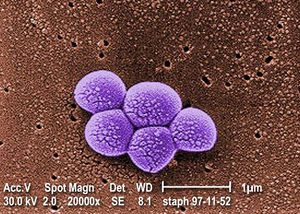Clostridium botulinum: The Duality of a Microbe
Section

By Juliette Leclerc
At right is a sample image insertion. It works for any image uploaded anywhere to MicrobeWiki.
The insertion code consists of:
Double brackets: [[
Filename: PHIL_1181_lores.jpg
Thumbnail status: |thumb|
Pixel size: |300px|
Placement on page: |right|
Legend/credit: Magnified 20,000X, this colorized scanning electron micrograph (SEM) depicts a grouping of methicillin resistant Staphylococcus aureus (MRSA) bacteria. Photo credit: CDC. Every image requires a link to the source.
Closed double brackets: ]]
Other examples:
Bold
Italic
Subscript: H2O
Superscript: Fe3+
Sample citations: [1]
[2]
A citation code consists of a hyperlinked reference within "ref" begin and end codes.
To repeat the citation for other statements, the reference needs to have a names: "<ref name=aa>"
The repeated citation works like this, with a forward slash.[1]
Section 1
Include some current research, with at least one figure showing data.
Every point of information REQUIRES CITATION using the citation tool shown above.
Clostridium botulinum is a gram-positive, rod-shaped, anaerobic, spore-forming bacterium. C. botulinum produces the neurotoxin botulinum, which causes botulism, a deadly paralytic disease in mammals. The botulinum toxin is the most potent toxin known to science, with 30 nanograms being enough to kill a human adult. Its optimal growth temperature is between 35°C and 37°C, and it cannot grow below a pH of 4.6. Its heat-resistant endospores are found in soil and can survive for an extended period of time in unfavorable conditions. The different types of botulism are foodborne, infant, and wound botulism. Foodborne botulism is acquired by eating contaminated food items, usually improperly canned foods. Infant botulism is also related to foods, such as honey, as their immune systems are not developed enough to prevent the toxin’s proliferation. Wound botulism is most prevalent in heavy intravenous drug users, such as black tar heroin. Clostridium botulinum is also used to make Botox, as it blocks the release of the neurotransmitter acetylcholine, temporarily paralyzing the muscles where it is injected. Botox is injected as a cosmetic procedure to smooth wrinkles, the effect usually lasting 3-6 months. The duality of Clostridium botulinum as a lethal neurotoxin and a cosmetic makes it exceptionally interesting to study.
Section 2
Include some current research, with at least one figure showing data.
Section 3
Include some current research, with at least one figure showing data.
Section 4
Conclusion
References
Authored for BIOL 238 Microbiology, taught by Joan Slonczewski,at Kenyon College,2024
